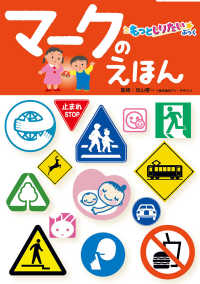- ホーム
- > 洋書
- > 英文書
- > Science / Mathematics
Full Description
FeFET Devices, Trends, Technology and Applications is essential for anyone seeking an in-depth understanding of the latest advancements in ferroelectric devices, as it offers comprehensive insights into research techniques, novel materials, and the historical context of semiconductor development.
This book serves as an encyclopedia of knowledge for state-of-the-art research techniques for the miniaturization of ferroelectric devices. This volume explores characteristics, novel materials used, modifications in device structure, and advancements in model FET devices. Though many devices following Moore's Law and More-Moore are proposed, a complete history of existing and proposed semiconductor devices is now available here. This resource focuses on developments and research in emerging ferroelectric FET devices and their applications, providing unique coverage of topics covering recent advancements and novel concepts in the field of miniaturized ferroelectric devices.
Contents
Preface xi
Acknowledgements xix
1 Scaling and Challenge of Si-Based CMOS: Past, Present, and Future 1
Shiromani Balmukund Rahi and Young Suh Song
1.1 Introduction to Si-Based CMOS Technology 2
1.2 Basic Concept of Transistor Scaling 3
1.3 Past Challenges in Scaling Si-Based CMOS 5
1.4 Present Challenges and Limitations of Si-Based CMOS 7
1.5 Representative Methods for Scaling MOSFET 8
1.6 Future Prospects and Innovations in Si-Based CMOS Technology 10
1.7 Navigating the Evolution of Si-Based CMOS Technology 10
1.8 The Future of Transistors: 2D FET 12
1.9 Conclusion 14
Acknowledgment 14
References 15
2 Ferroelectric Polymer-Based Field-Effect Transistor (FeFET) and its Applications 27
Dhrubojyoti Roy, Mohua Chakraborty, Dipankar Bandyopadhyay and Partho Sarathi Gooh Pattader
2.1 Introduction 28
2.2 Fabrication of Gate Dielectric Layer and FeFET 30
2.3 Working of FeFET 32
2.4 Applications of FeFET Device 33
2.5 Summary 46
Acknowledgments 47
References 47
3 Ferroelectric Applications in Novel Devices 57
Keshav Kumar and Umesh Chandra Bind
3.1 Introduction 58
3.2 General Concepts of Ferroelectrics 59
3.3 Ferroelectric Materials Processing for Device Applications 60
3.3.1 Bulk Synthesis 60
3.3.1.1 Solid State Reaction Method 61
3.3.1.2 Coprecipitation Method 61
3.3.1.3 Sol-Gel Method 62
3.3.2 Thin Films 62
3.3.2.1 Chemical Vapor Deposition (CVD) 62
3.3.2.2 Sputtering Method 63
3.3.2.3 Pulsed Laser Deposition (PLD) Technique 63
3.3.2.4 Molecular Beam Epitaxy (MBE) 63
3.4 Advanced Application of Ferroelectric Materials 63
3.4.1 Memory Devices 64
3.4.2 Energy Harvester 65
3.4.3 Space Flight/Satellite Electronics and Other Applications 67
3.5 Summary and Outlook 67
References 67
4 Optimization of Hetero Buried Oxide Ferro TFET and Its Analysis 77
Sirisha Meriga and Brinda Bhowmick
4.1 Introduction 78
4.2 Mechanism of the Device and Method of Simulation 79
4.3 Results and Discussions 81
4.3.1 The Fundamental Nature of Polarization 81
4.3.2 DC Analysis 83
4.3.3 Analog/RF Performance 87
4.4 Conclusion 92
4.4.1 Summary 92
References 93
5 Ferroelectric Material-Based Field Effect Transistor and Its Applications 103
Avinash Kumar and Balwinder Raj
5.1 Introduction 104
5.1.1 What is Ferroelectricity? 105
5.1.2 Effects of Temperature on Ferroelectricity 105
5.2 Ferroelectric Material Properties and Advantages 106
5.2.1 Common Materials for Ferroelectrics 108
5.3 Ferroelectricity in Nanoelectronics 109
5.3.1 HfO2 -Based Ferroelectrics in Nanodevices 109
5.3.2 2D Ferro2electric Nanomaterials 110
5.4 Structures of Ferroelectric FET 1112
5.4.1 Metal Ferroelectric Semiconductor Field-Effect Transistor 111
5.4.2 Metal Ferroelectric Insulator Semiconductor Field-Effect Transistor 112
5.4.3 Metal Ferroelectric Metal Insulator Semiconductor Field-Effect Transistor 113
5.4.4 Dual Gate FeFET 114
5.4.5 Fin FET 114
5.4.6 Gate All-Around Structure 115
5.5 Applications 116
5.5.1 Fe-FET-Based Memory Design 116
5.5.2 Fe-FET-Based Sensor Design 118
5.6 Conclusion 119
5.7 Future Prospects for Nanoferroelectric Devices 120
Acknowledgments 120
References 121
6 Ferroelectric Tunnel FET: Next Generation of Classical Low Power CMOS Technology 131
Naima Guenifi, Shiromani Balmukund Rahi, Houda Chabane and Khadidja Dibi
6.1 Introduction 132
6.2 Implementation of Ferroelectric Material in Tunnel FET 133
6.2.1 Device Structure 133
6.2.2 Device Lay-Out Information of Fe Tunnel 134
6.3 Results and Analysis 135
6.4 Conclusion 142
References 143
7 Identification of Negative Capacitance in Ferroelectric in FET Devices 155
Umesh Chandra Bind, Shiromani Balmukund Rahi and Keshav Kumar
7.1 Introduction 156
7.2 Negative Capacitance 157
7.3 NC in Ferroelectrics 161
7.4 Ferroelectric Materials in Practice for NC 164
7.4.1 Traditional Ferroelectric 166
7.4.2 Hafnium and Zirconium-Based Ferroelectric 166
7.4.3 Wurtzite Aluminum Scandium Nitride 167
7.5 Evidence of NC in Ferroelectrics 168
7.5.1 For the Concept of NC 168
7.5.2 For Device Fabrication 170
7.6 Perspectives 172
7.7 Conclusion 173
References 174
8 Tunnel Field Effect Transistors and Their Application in Biosensors 185
K. Manikanta, Umakanta Nanda, Pratikhya Raut and Biswajit Jena
8.1 Introduction 186
8.2 What is Biosensor: Types and its Principle 187
8.3 Components of Biosensors 188
8.4 Application of FET in Biosensors 189
8.5 How TFET Works as a Biosensor and its Structure 190
8.6 Recent Structures of TFET-Based Bio-Sensors 191
8.7 Conclusion 193
References 193
9 Transparent Conducting Oxides: Introduction, Types, Deposition Techniques and Applications 205
Isha Arora and Rishi Kant
9.1 Introduction 206
9.2 Physical Characteristics of TCOs 207
9.2.1 Optical Properties 207
9.2.2 Electrical Properties 210
9.3 Types of Transparent Conductors 212
9.4 Deposition Techniques 217
9.5 Sol-Gel Deposition 220
9.6 Applications of TCOs 223
9.7 Conclusion 227
References 228
10 Ferroelectric and FeFET Devices as Biosensors: Principle, Mechanisms and Applications in Health, Environmental, and Agricultural Monitoring 239
Umesh Chandra Bind, Keshav Kumar, Vimala Bind, Ajay Kumar and Jyoti Nishad
10.1 Introduction 240
10.2 Biosensors 241
10.3 Characteristics of Biosensors 244
10.4 Interaction Mechanism of Ferroelectric with Physical Stimuli 245
10.5 Working Principle of Biosensors 249
10.6 Biosensing Mechanism of Ferroelectrics 249
10.7 Ferroelectrics for Biosensing 252
10.8 Ferroelectrics in Health Monitoring 253
10.9 Ferroelectrics for Environmental Monitoring 257
10.10 Ferroelectrics for Agricultural Monitoring 258
10.11 FeFET Biosensors for Monitoring 258
10.12 Perspective 263
10.13 Conclusions 264
References 264
11 Ferroelectric Application in Recent Nanoscale Device with ITRS Roadmap 275
Shiromani Balmukund Rahi and Young Suh Song
11.1 Introduction to Ferroelectric Application 276
11.2 Ferroelectric Materials and Properties 276
11.3 Basic Scaling and ITRS Roadmap 279
11.4 Nanoscale Devices: Ultra-Thin-Body MOSFET, Gate-All-Around MOSFET, Gate, Channel, Source/ Drain Engineering, Local High Doping for Better Subthreshold Swing 280
11.5 Nanoscale Devices with Ferroelectric Applications 281
11.6 Advantages and Potential Applications of Ferroelectric Materials 282
11.7 Positioning of Ferroelectric Technologies in the ITRS Roadmap 284
11.8 Possible Challenge in Future Ferroelectric Applications 285
11.9 Conclusion 286
References 287
12 Recent Electron Mobility Models for FeFET 297
Shiromani Balmukund Rahi and Young Suh Song
12.1 Introduction to Electron Mobility and FeFET 297
12.2 Classical Electron Mobility Models 298
12.3 Quantum Mechanical Models for Electron Mobility 300
12.4 Density Functional Theory (DFT) Approaches for Electron Mobility 302
12.5 Empirical Electron Mobility Models and Parameter Extraction Techniques 303
12.6 Challenges and Limitations in Modeling FeFET Electron Mobility 304
12.7 Future Directions and Emerging Trends in FeFET Electron Mobility Modeling 306
12.8 Conclusion 308
References 308
About the Editors 319
Index 321







